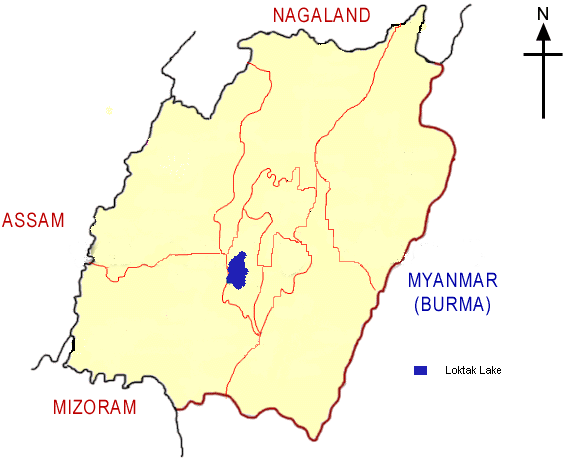Loktak Lake | 01 Aug 2022
Why in News?
Recently, Loktak Lake Authority of Manipur recently issued a notice to remove all floating houses and fishing structures on Loktak lake.
- This has evoked a sharp reaction from the local Fishing Community & Homestay Operators.
What are the Issues?
- There is a Lack of regulation.
- There is a growing number of homestays and huts that are constructed and have put the lake at risk, and impacted the environment.
- There has been a sharp reduction in fish production and the traditional fisheries due to a major hydropower project that was started in 1983.
- Also, there is a loss of agricultural land due to inundation and increased levels of sediments and pollutants by untreated rivers.
What do we Know About Loktak lake?
- About:
- It’s located about 40 kilometres south of Imphal.
- It's the largest freshwater lake in Northeast India, the pristine Loktak Lake is one of the most popular tourist attractions in Manipur.
- Known for its floating circular swamps, which are called phumdis in the local tongue,
- The lake invites tourists from far and wide for its ethereal beauty.
- These swamps look almost like islands and are a mass of soil, organic matter, and vegetation.
- The lake houses the only floating national park in the world, the Keibul Lamjao National Park, which is the last refuge of the endangered brow-antlered deer or sangai, Manipur's state animal.
- In addition, the lake shelters about 230 species of aquatic plants, 100 types of birds, and 400 species of fauna like barking deer, sambar, and Indian python.
- Loktak lake was initially designated as a wetland of international importance under the Ramsar Convention in 1990.
- Later it was also listed under the Montreux Record in 1993.
Way Forward
- As most of the floating homestay operators are educated unemployed youths, the government authority should suggest redesign and help them to make necessary changes by introducing dos and don’ts.
- Further, there is a need for the collective responsibility of every stakeholder to contribute to its conservation and maintenance.
UPSC Civil Services Examination Previous Year Question (PYQ)
Prelims
Q. Which of the following National Parks is unique in being a swamp with floating vegetation that supports a rich biodiversity? (2015)
(a) Bhitarkanika National Park
(b) Keibul Lamjao National Park
(c) Keoladeo Ghana National Park
(d) Sultanpur National Park
Ans: (b)
Exp:
- Keibul Lamjao National Park: Loktak lake hosts the world’s only floating national park, the Keibul Lamjao National Park. It is a natural habitat for the browantlered deer or the Sangai – which is the state animal of Manipur. The national park is characterized by many floating decomposed plant materials locally called ‘phumdis’ (a Manipuri word meaning floating mats of soil and vegetation). Loktak Lake is the largest natural freshwater lake in the north-eastern region of India and has been designated as a wetland of International Importance under the Ramsar Convention in 1990.
- Bhitarkanika National Park: It was declared as national park in 1998 and is located in Kendrapara district of Odisha. In 2002 it was included as a wetland of international importance under the Ramsar Convention. It is home to saltwater crocodile (Crocodylus porosus), white crocodile, Indian python, king cobra, black ibis, darters and many other species of flora and fauna. The Bhitarkanika sanctuary is the second largest mangrove ecosystem in India. It is inundated by a number of rivers – Brahmani, Baitarni, Dhamra, Pathsala. The park is famous for its green mangroves, migratory birds, turtles, estuarine crocodiles and countless creeks.
- Keoladeo Ghana National Park: It was formerly known as the Bharatpur Bird Sanctuary and is located in Bharatpur, Rajasthan. It is a famous avifauna sanctuary that hosts thousands of birds, especially during the winter season. It was declared a protected sanctuary in 1971. It is also a World Heritage Site and was designated as a Ramsar site under the Wetland Convention in 1981. It is a man-made and man-managed wetland. Over 230 species of birds are known to be residents.
- Sultanpur Bird Sanctuary: Sultanpur Bird Sanctuary, located at the Gurugram district of Haryana, is home for several migratory bird species. Its small area comprises shallow freshwater Sultanpur Lake, where 100 of migratory bird species visit to feed every year. The Sultanpur National Park is known for its rich variety of birds such as Siberian cranes, greater flamingo, ruff, black-winged stilt, common teal, common greenshank, and northern pintail, yellow wagtail, white wagtail, northern shoveller, and rosy pelican. Therefore, option (b) is the correct answer.
Mains
Q. What is wetland? Explain the Ramsar concept of ‘wise use’ in the context of wetland conservation. Cite two examples of Ramsar sites from India. (2018)

